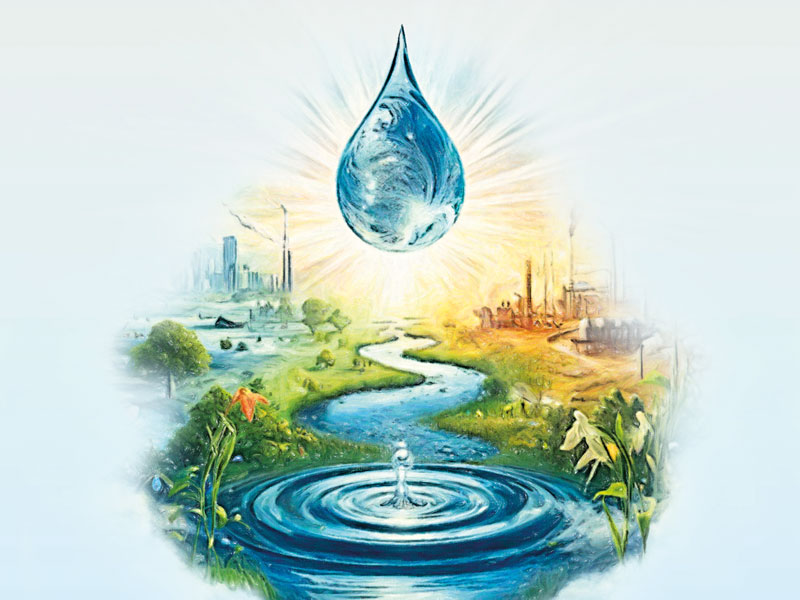
& nbsp
Author: Oliver Hackel, strategist for senior investments, Kaiser Partner Privatbank Ag
In an era of accelerated climate change and increased environmental stress, water becomes an increasingly rare strategic resource. Water, however, is not only an elixir of life, but is also associated with natural disasters and geopolitical conflicts. As a grandfather of sustainability, the water theme offers enormous potential for investors. Investments in innovative water companies generate financial return and diversification, but also a societal dividend.
Approach environmental stress
We have an apparent superabundance of water in our corner of the world, but in the world, water (drinking) is a rare goods which becomes increasingly rare. The increase in environmental pollution caused by industrial waste, chemicals and plastics puts pressure on water resources worldwide. At the same time, climate change causes extreme weather events such as droughts, floods and serious storms that disrupt natural hydrological balance and further destroy an already tight water supply. The agricultural, industrial and urban overuse of water resources also worsens the problem and endangers whole ecosystems. These ecological challenges have deep social implications.
In many developing countries, millions of people do not have access to drinking water, which causes health risks such as cholera and typhus and causes high infant mortality. Women and girls suffer particularly because they are often responsible for recovering water and thus lacking educational and career opportunities.
Whole communities have literally “water to their necks”. According to the World Health Organization (WHO), investments in drinking water could prevent up to 1.6 million deaths each year. Participation and investment and investment in the water issues are committed is both economic and ethical.
The thirst for artificial intelligence
Water plays an increasingly important role in the technology sector. The rapid boom in artificial intelligence (AI) and cloud technologies gives rise to water consumption because high -performance data centers consume huge quantities of energy and must therefore be cooled effectively.
Although part of the water used to cool them can be recycled, a large part of it is lost in evaporation. In addition, the abstraction of water for data centers is often concentrated regionally, which creates additional challenges in arid areas such as the American state of Arizona or parts of Spain. Thus, the pressure rises on technological companies to develop more sustainable methods. Closed recirculation cooling systems, the use of rainwater and low evaporation technologies are considered promising solutions for the thirst of AI for water without further support for global water resources.
In addition, the selection of the site plays an ever more important role in the protection of water reserves. Meanwhile, investors and the public require transparency, forcing companies to disclose their water consumption and to present strategies to reduce it.
Ocean drinking water
More than 97 percent of water on earth are not oral fresh waters, but are salty and non -pavable. Desalination of seawater is therefore largely considered one of the most promising approaches to sustain stress on global water resources. Progress in fields such as reverse osmosis and innovative membrane technologies allow more effective treatment of salt water.
The high demand for energy from desalination factories had long been a drawback, but renewable energies and heat recovery reduce their consumption today up to 40%. Examples like Israel and Singapore show how almost autartic water circuits can be created thanks to a combination of desalination, sustainable water management and recycling. This can relieve traditional sources of fresh water and facilitate regional shortages. Rigorous research and investments in the widening of these technologies in an environmentally friendly manner is necessary to allow solutions of this type of catching up around the world and making water infrastructure more resilient.
Water as a growth factor
Water is an engine of economic advancement. From the food and drinks and textile sectors to data centers in the manufacture of semiconductors and AI, practically each industry depends on a secure water supply. Decreasing availability of “blue gold” has a direct impact on the production capacity of whole branches of the industry and can permanently slow down economic growth in the affected regions. If water sources are dry, the production and economic growth of the stand. The OECD warns that the worsening of the water crisis could reduce global economic production by 8% by 2050. Some developing countries could even see a 15% drop in economic production. The obsolete water infrastructure now already causes economic costs totaling $ 470 billion per year.
Risk factor
Water, however, is not only a growth factor, but also a risk factor. The World Bank calculates that the damage caused by urban floods cause costs amounting to $ 120 billion per year. While manufacturers must ask themselves if they want to continue to build in areas threatened by the risks of water, insurance companies weigh more and more if they always wish to ensure these risks in the future. For other companies also, water is becoming more and more a strategic problem requiring proactive management. The regulatory requirements rise, as is the penalties looming for non-compliance. In addition, if companies do not take into account sustainability in their water management practices, they are also likely to harm their reputation and lose the confidence of investors, customers and the public.
Water – and its rarity – is also increasingly the cause of geopolitical conflicts. An example of this is the great dam of the Ethiopian Renaissance, whose construction is tightening the already fragile relations between Ethiopia, Egypt and Sudan because the fall in the water level of the Nile threatens the means of subsistence of countless people.
In Iran, in turn, the persistent droughts exacerbated by decades of mismanagement pushes people to descend into the streets in mass manifestation while the water shortage depopulates whole regions and feeds social conflicts. Even in the United States, the overuse of the Colorado river is becoming more and more a stress test because drastic water conservation measures are inevitable and the urban water agriculture and supply networks both reach their limits. Diplomatic skills and political provident strategies are necessary to avoid climbing and protect long -term stability.
Grandfather of sustainability
The water can be unpredictable and extremely powerful. But humanity has also exploited water power for decades. As a grandfather of sustainable electricity production, water is convincingly convincingly as a source of stable energy, reliable and flexibly deployable which does not dry even during the “dark marasses” (periods of little or no sun and no wind).
Hydroelectric energy contributes to the safety of energy supply and is an invaluable skeleton of the energy transition. The subject of water also presents a good place in the United Nations Sustainable Development Goals (SDGs), weaving them as a blue ribbon because of its social, economic and environmental relevance.
The water is also explicitly mentioned in the target of sustainability number six (drinking water and sanitation), which is unfortunately still far from the realization. Although access to drinking water and sanitation is a fundamental human right, 2.2 billion people in the world have always refused this fundament of health and well-being in 2022.
Water is a theme also established with regard to investment in sustainability. The first “common funds” were launched approximately 25 years ago. They mainly invest in companies related to the exploitation of public water supply, water technology and environmental services.
The public and industrial services sectors generally represent more than 80% of a typical “water portfolio”, which thus combines defensive and offensive qualities and promises a good risk / reward compromise at least on paper. However, due to the high sectoral concentration, the supposedly good yield adjusted to the risk only comes at the cost of having to bear a high follow -up error compared to the world market of actions (for example, the global MSCI fund index), and it is if the performance promise is even held at all.
Although the active management of a thematic fund has a lot of sense in theory, because it makes it possible to react to under-tends and on or in insufficient insufficient companies fundamentally strong or weak, in the practice of the real world, the majority of water fund managers do not succeed in beat the relatively simple passive water indices. Investors must therefore wonder if they have the capacity to identify the best managers or must promote the more promising and cheaper alternative presented by an ETF of the water.
There is also a third option, although it is only in question for active investors, and it is to choose actions individually linked to water instead of investing in a common investment fund or an ETF. In this way, you avoid product costs, but include the risk of active management yourself. Whatever the variant that an investor chooses ultimately, in an era of richly appreciated American technological actions, a “water portfolio” creates not only a diversifying counterweight, but can even help to mitigate the consciousness of an investor.
